Media | Articles
20 years on, Honda’s S2000 leads the pack
Roadster lovers were spoiled for choice in the early 2000s. Following the surprise, smash success of the original Miata a decade earlier, automakers rushed to feed a growing hunger for dedicated, two-seat open-air sports cars. These days, the Honda S2000 is among the most beloved (and highest-valued) of these successors. In fact, for more than five years, pre- and post-refresh S2000s have sat atop the 2000s-era roadster market. So what’s this Honda’s secret sauce?
The front-mid-engine, rear-drive, six-speed-manual-only S2000 reached showrooms for the 2000 model year, which made it fashionably late to this topless party. The Germans were first to the jump, with the BMW Z3, Mercedes-Benz SLK, Porsche Boxster, and Audi TT all arriving by 1998. Each car had its merits—the Z3’s smooth straight-six, the SLK’s luxury appointments, the Boxster’s expert chassis balance, and the TT’s cutting-edge Bauhaus design. Leave it to Honda, however, to take the Miata’s formula of sports car purity and add a dose of high-revving thrill.
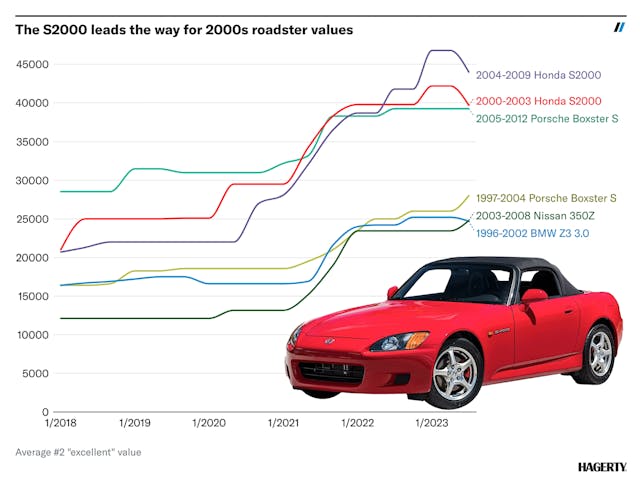
Based on the Honda Sport Study Model concept for the 1995 Tokyo motor show, and drawing influence from classic Honda roadsters like the S500 and S800, the S2000 prioritized light weight, balance, and responsiveness. The SSM concept drew inspiration from Honda’s Formula 1-winning race cars of the mid-1960s, which won acclaim for their compact and lightweight V-12 engines.
The S2000 does not pack a V-12, but its F20C naturally aspirated four-cylinder was nonetheless remarkable for its time. The aluminum-alloy, dual-overhead-cam engine featured Honda’s signature VTEC variable valve timing, along with a screaming 8800-rpm redline that yielded 240 hp and 153 lb-ft of torque from just 2.0 liters of displacement. Those numbers amounted to the highest specific output (power per liter of displacement) of any production engine in the world at the time.
Honda’s “high X-bone frame” and monocoque body allowed for the engine to be positioned as far toward the center of the car as possible, helping the S2000 achieve an enviable 50:50 weight distribution. Sixteen-inch wheels wrapped around 11-inch disc brakes, hiding double wishbone suspension all around. Known for its fantastic manual transmissions, Honda developed an all-new six-speed for the S2000 that included close-ratio gears, a short and direct-feeling linkage, and lightweight flywheel. A Torsen limited-slip differential came standard.
The car was an undeniable success, touted by media and owners alike for its unfiltered, unfettered sports car experience. Its $32,000 starting price was considerable at the turn of the millennium, when the Accord cost half that much. The S2000 was, however, about six grand cheaper than a comparable Z3, and roughly fifteen grand cheaper than a base-model Boxster. In typical Honda fashion, it was a car that overperformed for its price point and won legions of followers. More than 113,000 S2000s were sold globally until it went out of production after the 2009 model year, with U.S. customers accounting for 66,000 cars—more than half of the total run.
Rarity, then, is not a factor driving the S2000’s value and desirability. Instead, we’d argue, the motivating forces here are twofold: a carefully distilled driving experience and its uniqueness in the pantheon of Honda sports cars.
An S2000 at full blast is a singular experience. Even the 2007 AP2 car we drove at Michigan’s GingerMan Raceway, with its slightly tamer personality compared the earlier AP1, offers delightful sensations that the great-driving Boxster can’t match. The engine is the star—lively and fearsomely responsive to your right foot. Between 6000 rpm and its peak at 8000 rpm, the updated “F22C1” 2.2-liter produces a gorgeous, eager hum. AP1 cars take that sensation further with their higher redline, albeit at the expense of mid-range oomph and tractability on ordinary driving.
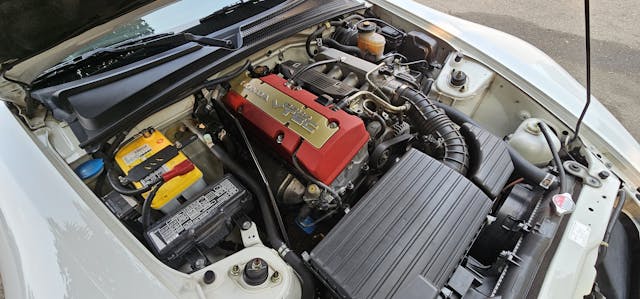
We were able to tackle most of the track in third gear alone. During our first passes on the front and back straight at GingerMan, however, we accidentally short-shifted a few hundred rpm shy of the limiter, trusting our ear instead of the F1-style digital tachometer. The shifter is picture-perfect, with short, deliberate throws and a more mechanical feel with each gear engagement than in a Z3 or Boxster.
The chassis, too, feels distinctive. You notice this mostly through the car’s balance, which remains consistent and predictable even at high speed and under heavy inputs. (AP2 cars are known to be more forgiving in this regard, following suspension changes to the original AP1 that in some customer hands resulted in unexpected oversteer.) Body roll is minimal. The S2000 changes direction seemingly the moment you command it to, dancing through a succession of tighter, faster corners with delightful disregard for inertia. Steering is electrically assisted but sniper-precise and mighty quick. Feedback via the Boxster’s and Miata’s steering wheel is perhaps more nuanced, but only the S2000 makes you feel like you’re wearing it rather than driving it.
Interior designers took a minimalist approach to the S2000s interior. It’s snug rather than cramped, but for longer road trips something like a Nissan 350Z would be more comfortable. Everything is arranged with the driver in mind. The tidy suite of climate controls are stacked next to the steering wheel. There is no typical center console, and even the radio is hidden behind a small plastic door. The steering wheel itself is small without feeling dainty, with thin yet still substantial-feeling rim. Leather trim on the seats and doors offers a slightly more premium experience than your typical 2000s Honda, which helped justify the S2000’s position above the Miata in the marketplace.
Looking at #2-condition (Excellent) cars, AP2 S2000 values surpassed the earlier AP1 in early 2022. One possible explanation for this phenomenon is that they’re newer and lower-mileage, as well as a bit more usable in daily driving thanks to the improvement in low- and mid-range torque.
No S2000 commands more dollars in the market than the Club Racer, however. This limited-run, special-edition S2000 was specially tuned for track work. Offered solely for the 2008 and 2009 model years, the CR represented a subtle but comprehensive overhaul of the entire S2000 package. At launch, American Honda executive vice president John Mendel called the CR “the closest thing you can get to a Honda-built racecar with license plate holders and a horn.” Changes included revised exterior aerodynamics, structural bracing and stiffening, a standard aluminum hardtop replacing the ordinary soft top, a quicker steering ratio, stiffer dampers and anti-roll bars, wider wheels (still measuring 17 inches in diameter), and a cloth interior with yellow stitching. Total weight savings amounted to 90 pounds.
In the CR’s case, rarity certainly plays a role in its appeal. Honda built fewer than 700 examples when production was cut short mid-2009, ostensibly in light of slowing sales following the global financial crisis.
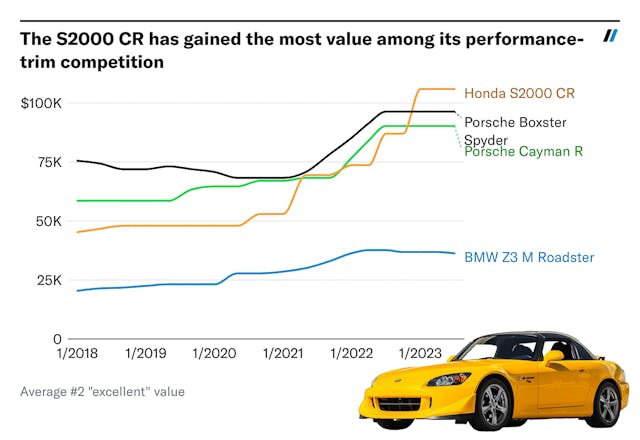
An S2000 CR in Excellent condition now commands $108,000, an increase of 21.5 percent over the last year. For context, that’s the exact same price for a 1992 Acura NSX. A base AP2 S2000 over that same time frame has gained just 5.3 percent, costing $44,000 on average. This massive price leap for the CR exceeds even what we’ve seen from the Porsche Boxster Spyder and Cayman R, as well as the BMW Z3 M Roadster.
Jonathan Wong owns the white S2000 featured here. He’s had a blue 2008 CR in his stable since 2011, a car he’s casually and regularly tracked throughout his ownership. Wong picked up the white car a couple years ago after driving a friend’s modified S2000, eager to dive into a higher-mileage car that he’d feel comfortable tweaking as he saw fit.
“I knew there was a possibility that if I went down the modification hole, I may end up going farther than I originally intended to. Was I going to do those things to my still clean, low-mileage CR? I thought about it for a second, but I stuck with the promise I made to myself when I originally bought the car 12 years ago that it would remain stock.”
So far the only changes he’s made to his white 2007 are braided brake lines with high-performance fluid and pads, but he’s eyeing a set of Öhlins suspension to swap on when time allows.
For normal road driving, he already much prefers the standard S2000 to the CR: “My white S2000 is certainly more compliant compared to the CR,” he says. “There’s more give in the suspension, which is very appreciated while bumming around town and taking drives across the state. In the CR, after a driving a couple hours to and from GingerMan from metro Detroit for an open track day, I’d feel wrecked. That’s not the case in the white car, which is not itself a luxurious ride, but the difference is noticeable.”
Naturally, the CR has the edge on track. “The CR feels a touch more buttoned-up—crisper and more rapid to respond at turn-in. Weight transitions are quicker side to side and under braking. All of that stiffening and bracing don’t represent a gigantic leap over the stock car, but they sharpen an already sharp knife. The base car is still hugely enthralling to drive on a track, though, more so even today’s Mazda Miata with its high dose of body roll before the car takes a set.”
Regardless of which S2000 enthralls you most, all signs point to Honda’s roadster remaining a healthy collectible for the foreseeable future. Maintenance is not Civic-cheap, but it’s certainly more palatable than a Boxster or Z3, and the clean, frill-free styling has aged well since the car’s debut more than two decades ago. And for Honda die-hards in the U.S. especially, the S2000 represents an anomaly—the brand’s only rear-drive sports car on these shores since the Acura-badged NSX supercar. It’s a dedicated roadster on a specialized platform, a consequence of several driving-obsessed Honda engineers scrambling into a room and locking the door before the marketing wonks could claw their way inside. A Honda with the S2000’s particular combination of power, agility, and classic sports-car design is a special one, indeed.
***
Marketplace
Buy and sell classics with confidence
Check out the Hagerty Media homepage so you don’t miss a single story, or better yet, bookmark it. To get our best stories delivered right to your inbox, subscribe to our newsletters.
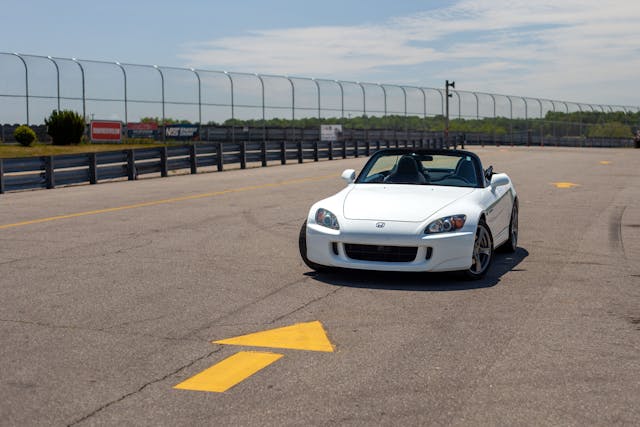
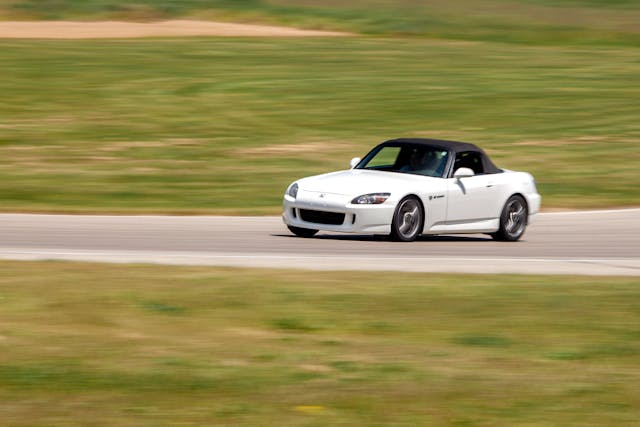
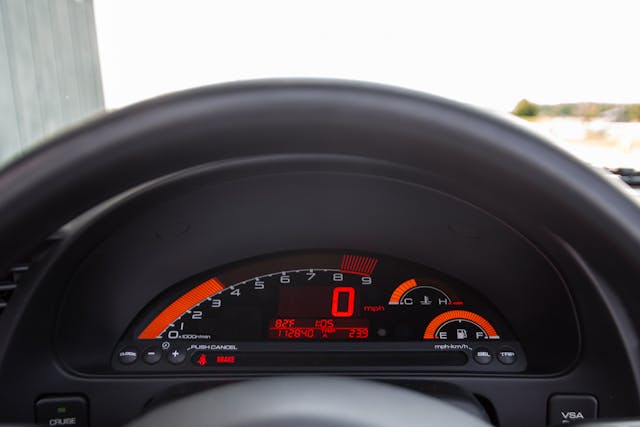
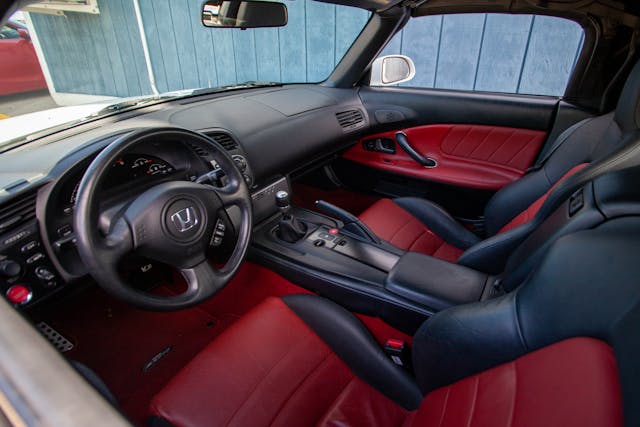
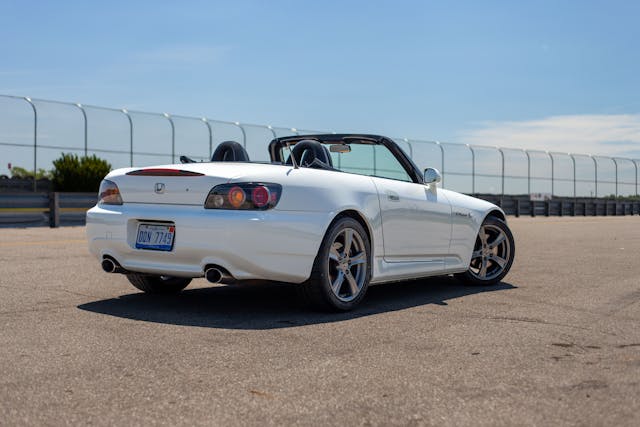
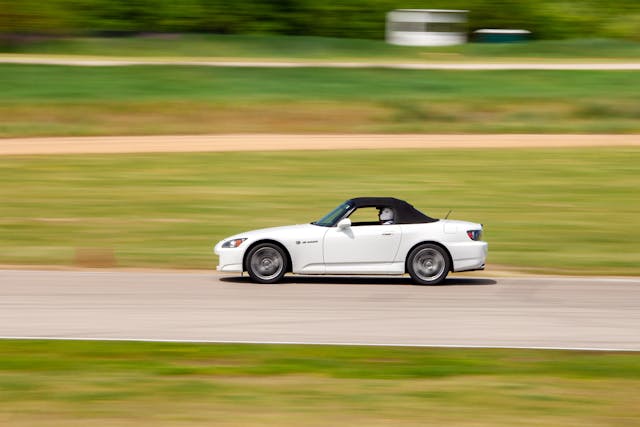
















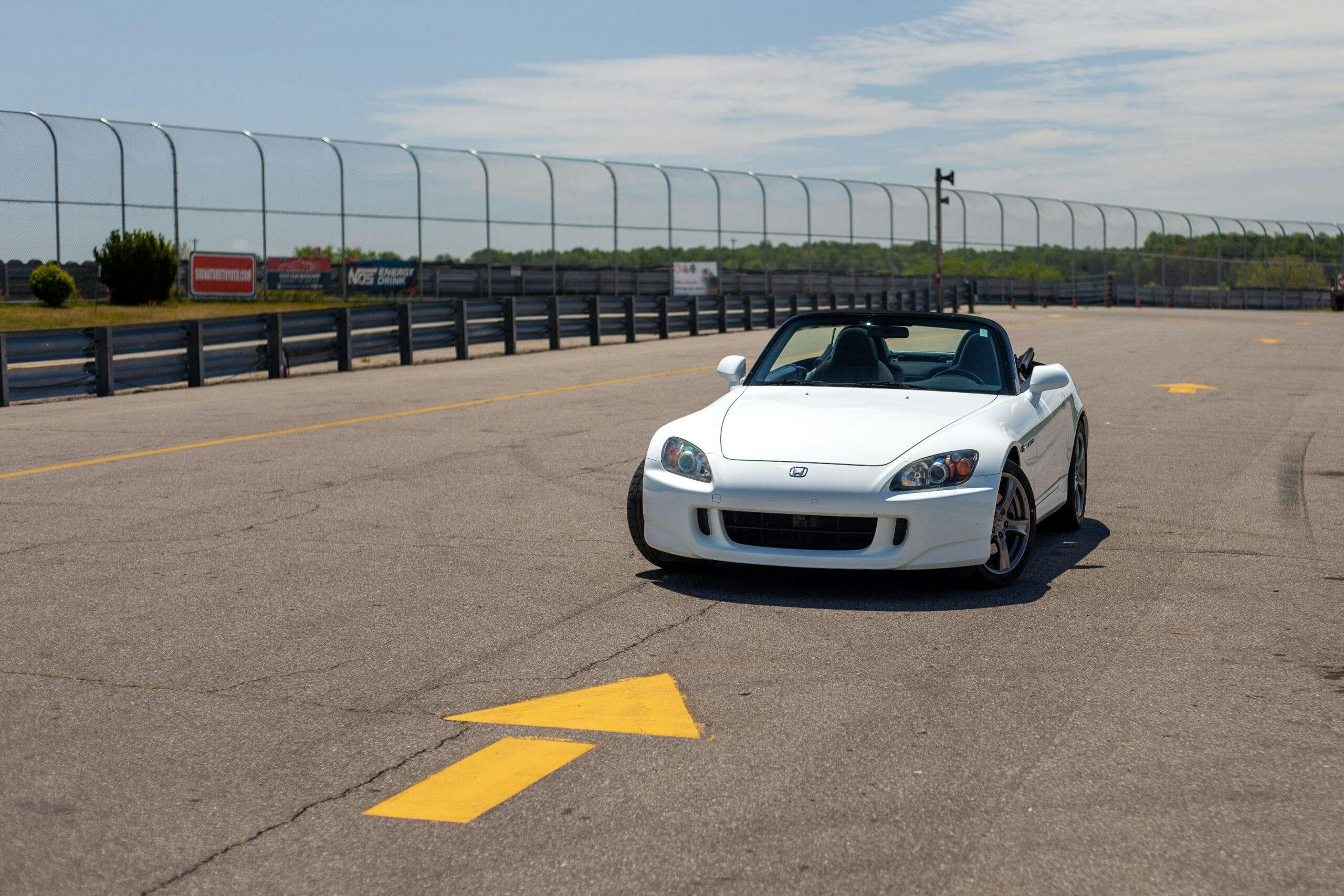
I never found this car interesting. When you have to rev it so much to get anything out it just never appealed to me.
But to be fair I was raised on low end torque and flat torque curves. Revs may be great in F1 but on the street give me the low end and or flat torque curves. My LNF 2.0 Turbo made full torque and power from just off throttle to 5600 RPM on 23 pounds of boost. I could draw on power anytime but getting it to the ground could be a challenge at times. The Pilots did not grip.
I still remember driving the Honda Canada press car when it launched! I remember it being a great handler and the VTEC!!!!!!!!! Nothing without a rotary engine hit those RPM’s in this price bracket!
A great all rounder that you could drive everyday without fail and still have fun on the weekends.
I will never understand the repeat articles.
I’ll take an AP1 or AP2 and rev the heck put of it. Fun cars.
Gary — the readership at insider.hagerty.com and hagerty.com/media are different, which is to say not everyone reads both sites. Insider focuses exclusively on valuation and the market, while Hagerty.com/media is more general-interest. There is a degree of overlap, but we still publish some articles on both websites to make sure it gets viewed by the widest audience. Does that clear things up?
I bought my 2000 S2000 (60,600 miles) on Ebay in Oct. 2014. I was the only bidder and got it for $12,000. Lucky me! It was in very good shape. Because of the age I installed a Koyo all aluminum radiator, starter, cloth top with glass window and a set of Continental Extreme Contact tires. Last year I installed a stock clutch. Car $12,000 +improvements $2,100 = $14,100 total. I did all the work myself. I know I could sell it and make bag full of money, but I have no intension of selling it. It is a remarkable auto that is so much fun to drive. Yes, the lack of mid torque is the only flaw i see. I got over that quickly. As most of us know, Honda knows how to build a car.
Nice! I own a ’88 Crx which I love, but you have the car of my dreams.
I have a totally stock 1999 Honda Civic HX, 5 speed. Double wishbone suspension at all 4 corners and fun to drive. I love it!
Awesome car! I put down a deposit for an early one, just from the pictures. Glorious day when mine arrived, red exterior. Sadly, I found out the Japan home market design cockpit was just too small to get my legs out of the car, not to mention my knees bashing the wheel when trying the pedals. Sad day, I had to pass the car to the next in line. Not made for tall people with longer legs. All of my other Hondas fit, just not this one. I’m even sadder when seeing the long term values.
I love the 2005 Black Roadster my sons first new car after he graduated from college. I have it now and will take good care of it until I tip over, then he will get it back. I’m taking good care of it and nothing compares to driving it through the gears reminiscing about my ‘57 Alfa Romeo Gulietta after a tune up
I have owned three S2000 and the current one is here to stay! A fun car to drive!!!
2003 Sebring Silver Metallic with red leather interior here. Bought her new on 9-26-03. Just over 37k on the clock at present. Basically stock with a few nice personal touches. Still run the factory 16″ rims. Love the car!
I did two things which did a reasonably good job of taming the twitchy snap oversteer potential of the AP1. First I installed a MUZ Whiteline front swaybar #BHF48 (30mm solid spring steel, 50% stiffer than stock tubular 26.5mm). Then I had the Honda UK spec AP1 4-wheel alignment done which is much more aggressive at the expensive of tire wear.
UK Euro specs:
front caster: 6.45°
front toe: 0.0°
rear toe: 0°20″ (3mm per side or 6mm total or 1/4″ = 0°40″ total)
front camber: -1.0°
rear camber: -2.0°
Love my 2006 S2K with only 7,000 miles on it since day one when I leased it new and then bought it. I’m 76 years old and still get a thrill whenever I drive it! Loved the article! Thanks!
Love my 2006 S2K with only 7,000 miles on it since day one when I leased it new and then bought it. I’m 76 years old and still get a thrill whenever I drive it! Loved the article! Thanks!
I very much enjoyed this article, with a beautiful, White S2, just like mine. ( 2004 ) at 73 years old. It’s still the most fun car I’ve ever owned. drives like you’re riding on a rail.
Given its high-strung nature, the S2000 isn’t going to appeal to everyone and that’s okay. I love that Honda stuck to their vision of what a sports car should be when it came to this car. The fact that they offered it only in roadster form with nothing but a manual transmission makes it all the better in my opinion.
The great engineering behind the S2000 also extends to how well the car was laid out. It is clear that Honda took the tasks of the mechanic into consideration as most everything is very accessible — making it a car that is not only fun to drive but also really nice to work on.
Oct. 2013 I bid on a 2000 S2000 on ebay. Mileage was 60,600 mi. I was the only bid at $12,000. Lucky me! It was in very good shape. I met the owner at the bank and she was mine. When I left the bank I went 3 miles to I-75. I was waiting on the red light to get me on the entrance ramp north. It had been raining. When I got the green light I shifted from 1st to second gear. As I turned the rear end broke loose. There I was going backwards down the ramp at about 40 mph. I went another 45 degrees into the grass area. A 270 degree spin.
First couple of years I made inprovements on what was needed. I did all the labor myself and saved mucho dollars. In 2021 I replaced the clutch and surfaced the flywheel ($500). I have put 12,000 miles on her and never had any problems. I own a 2006 Corvette convertible with 8,400 miles. To let you know I am selling the Vette this spring and yes, I’m keeping the S2000. Love my S2000 and don’t expect to sell it.
I have had two Honda Motorcycles and four wonderful cars. CRX included.
I would love to have an s200 or Honda type R.
10+ years ago I asked Hagerty about covering my 2001 Honda S2000 – and they literally laughed in my face and told me they wouldn’t insure that car. How times have changed.